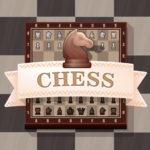Chess




 (No Ratings Yet)
(No Ratings Yet)Board Game Chess Multiplayer Strategy map 22 Jan , 2021 0





 (No Ratings Yet)
(No Ratings Yet)Board Game Chess Multiplayer Strategy map 22 Jan , 2021 0

Chess is a two-player strategy board game played on a checkered board with 64 squares arranged in an 8×8 grid. The rules of chess are published by FIDE (Fédération Internationale des Échecs), chess's international governing body, in its Handbook. Classic Chess Piece are divided into white and black sets. While the sets may not be literally white and black (e.g. the light set may be a yellowish or off-white color, the dark set may be red), they are always referred to as "white" and "black". Each set consists of 16 pieces: one king, one queen, two rooks, two bishops, two knights, and eight pawns.
Click a piece you want to move, possible tile move with blue or green color will be shown, then click one of them.
Embed this game

